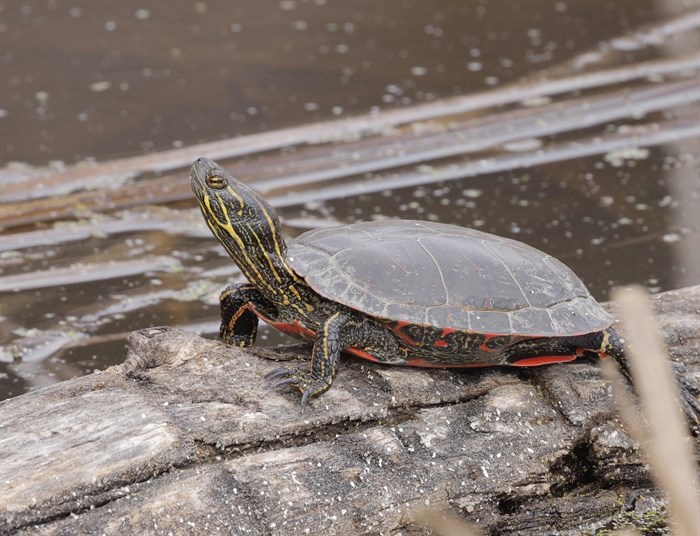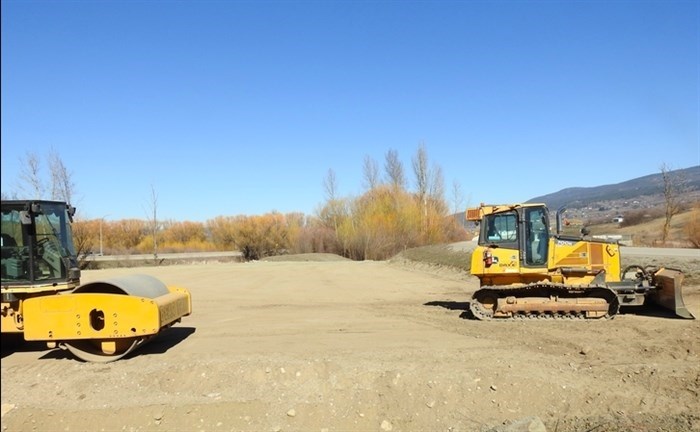
A painted turtle sits in a pond off of East Shuswap Road in Kamloops.
Image Credit: SUBMITTED/ Lyn MacDonald
April 08, 2024 - 6:00 AM
Wetlands continue to be lost or damaged by human development adding an increased risk during extreme weather emergencies and putting more species of wildlife in peril.
“I think a lot of people don’t learn or think about wetlands and so they don’t realize how important they are,” BC Wildlife Federation wetland educator Alana Higginson told iNFOnews.ca.
“Wetlands filter water and mitigate flooding, fires and drought which is critical right now. Over 600 species of wildlife depend on them and one third of our species of conservation concern depend on them.”
Roughly 85 percent of wetlands in the South Okanagan have been lost or damaged, particularly in the valley bottoms where there is the most development, and it comes with repercussions.
For example, in 2023 thousands of residents in the Okanagan and Southern Interior were forced to evacuate their homes due devastating wildfires.
Wet landscapes can slow the progress of wildfires, and provide water for fire crews, and refuge for wildlife and livestock, according to Ducks Unlimited Canada. Also, during extreme flooding emergencies, the wetlands can moderate water flow and erosion by storing water.
Wetlands recycle nutrients, have a cultural significance and give value to tourism, science and learning, but Higginson said it can be difficult to convince the public how important they are and why they shouldn't be developed.
“I tell people all these important reasons, we’ll have a reduction in water supply, we’ll be more prone to drought, floods and fires, we’ll lose wildlife biodiversity, but a lot of the time it comes down to an economic thing. We don’t have a full provincial outline on the economic values wetlands provide us.”

This once was a wetland that is now filled in to make it ready for commercial development.
Image Credit: SUBMITTED/ Jack VanDyk
Despite the ongoing work by provincial organizations like the wildlife federation to protect the wetlands, they continue to be destroyed.
Last month, a development in Vernon mowed over a wetland next to BX Creek south of Highway 97.
“Going back to pre-settlement times, that whole area was probably marsh or a wetland,” North Okanagan Naturalists' Club president Harold Sellers told iNFOnews.ca in a previous interview.
“BX Creek had a lot of diversion and channelization early on. That’s where it flowed into Swan Lake so I’m sure that was all a marshy area, much like what you see at the south end of Swan Lake now but it was a much greater area at that time.
“The creek still flows through there but I would say there is no wetland still existing there, with the road development and the fill that has been brought in. There’s no cattail marshland like there used to be.”
READ MORE: Lac Le Jeune resort near Kamloops reopens five years after closure
As a result of the development, Sellers said, there is less area for species to live and loss of natural flood control.
Between 60 and 90 percent of wetlands in the province have been lost, Higginson said.
In Kamloops, conservation and naturalist groups have been caring for a large wetland located on the north shore of the South Thompson River to control invasive weeds originally planted for cattle forage.
Tranquille Wetland is a habitat for several species of migrating and nesting birds, and a feeding area for raptors and other prey animals. It’s a carp spawning habitat and home to some rare plant species.
READ MORE: iN PHOTOS: Western painted turtles spotted sunning themselves in Kamloops, Okanagan
Higginson said there are a ton of ways for people to get involved in preserving what is left of wetlands including joining local naturalist groups, attending educational workshops and reporting invasive species.
The biggest way to help preserve wetlands is to make your voice heard.
“People can attend local planning meetings regarding development proposals and let local governments know how important a wetland is. I’ve seen quite a few examples where decisions have been made, proposals have been shut down. The more people willing to get out there and get heard, the better the chances.”
READ MORE: Penticton brewery hosting memorial for beloved Kevin the Goose
The wildlife federation is currently working on a wetland restoration project in Vernon in partnership with the North Okanagan Naturalist Club.
The provincial Marsh Monitoring Program is a partnership between WildResearch and Birds Canada and its putting on a marsh workshop in Kamloops this month.
A free three-hour workshop will be held at the Hal Rogers Community Hall in Kamloops from 5 p.m. to 8 p.m. on April 26, with presentations on amphibians, plants and birds in the Thompson- Nicola Region. The following day participants will head to a local park or protected area to practice surveying for habitats, amphibians and birds.
To register for the workshop email bcmmp.kamloops@wildresearch.ca.
To contact a reporter for this story, email Shannon Ainslie or call 250-819-6089 or email the editor. You can also submit photos, videos or news tips to the newsroom and be entered to win a monthly prize draw.
We welcome your comments and opinions on our stories but play nice. We won't censor or delete comments unless they contain off-topic statements or links, unnecessary vulgarity, false facts, spam or obviously fake profiles. If you have any concerns about what you see in comments, email the editor in the link above. SUBSCRIBE to our awesome newsletter here.
News from © iNFOnews, 2024